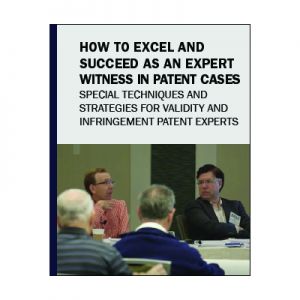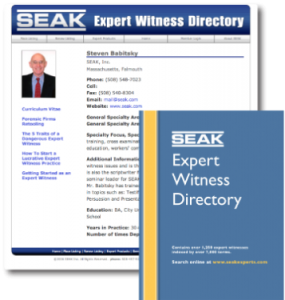Excerpted from SEAK’s Course: How to Excel as an Expert Witness in Patent Cases: Special Techniques
When you go to the expert witness directory, all right, make sure your online profile is top notch. All right? Get a good, professional photograph. All right? Because I’ve had, when I started talking about LinkedIn, some of the older people in the audience said, “I’m not going to put my photo on a website.” I said, “Get over it,” right? “Get over it. Real fast.” Because you wouldn’t go to a networking organization or a networking event, all right, where you’re gonna meet people, potential connections. I said, “No photo on your website or your LinkedIn profile is like going to a networking event with a paper bag over your head.” No one would do that, right? They want to see what you look like. Especially attorneys want to see, “I can put this person in front of a jury?” Right? Make sure all your contact information is there. I think Steve mentioned this yesterday. Sometimes it’s maddening because you try to contact somebody? You don’t have an email address or you don’t have a correct phone number. So make sure that’s there. Have your current CV. If there’s one thing you need to keep current is make a schedule to update your CV, because a lot of you guys are busy. You have lots of cases. You have new experience that you have. New cases that give you new knowledge. You need to continue to update. The ones that are on your website, put “not retained” in the watermark. How many people use that little trick? Yeah, if you’ve taken a course you know that your CV online should have “not retained” in the watermark in it. All right? Male: What is that for? Instructor: That’s so that if it’s not quite up to date, right? You always have the most up to date CV that you provide to the attorney. All right? So if somebody said, “Oh, I already have your CV.” I said, “Well, did you get it from my website?” “Yeah.” I said, “Well, let me send you my current CV.” All right? So make sure that your website CV is always up to date. But I just always send them an unwatermarked version when I’m in the process of being retained. Yeah. Yeah, you can link to…most of the directories allow you to link to your LinkedIn profile. Yeah. Education, specialties. I actually write in Word…I have in Word a short paragraph for the intro section because most of these directories they give you like 200, 250 words, right? Where you can sort of put a synopsis. And then a lot of them have areas where you can put detailed bullet lists or things like that. And they have a section where you have specific areas of expertise. And if you have issued patents, make sure you list them. All right? Because, you know, if an attorney sees an expert, like in my case I have 15 issued patents, 6 patents in process. They’re gonna say, “Oh, he’s got 6 patents in process and he’s got 15 issued,” right? “The guy knows the patent process. At least he has some patents himself or herself.” So list those because that could be really important in showing your expertise in not only as an inventor but, you know, you have a specific specialty. And then get your specific focus areas.
Some of the online directories will let you upload presentations. So I have a…Steve yesterday talked about the SEAK blog. I have a blog post on SEAK that says “Type of Cases For a Polymer Expert Witness.” Well, I have this whitepaper. Well, I put it on the SEAK blog post but I have a PDF of it, right? That I put on my InnoCentrix format and all that stuff. And I upload that onto the SEAK Expert Witness Directory. I also have a whitepaper on intellectual property, right? So if an attorney goes and looks at my profile and I have a whitepaper on intellectual property and he downloads it and reads what I know about intellectual property, then he goes, “Ah. Okay.” That always helps. Your memberships are on there. Litigation experience. I don’t list my actual cases. This is another area where some people have questions of, “Should you list your actual…?” So what I do is I…on the expert witness directories I have like 10 cases involving patent infringement deposition, litigations…


